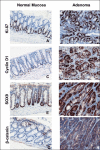Oral administration of the anti-proliferative substance taurolidine has no impact on dextran sulfate sodium induced colitis-associated carcinogenesis in mice
- PMID: 20442801
- PMCID: PMC2862504
- DOI: 10.4103/1477-3163.62536
Oral administration of the anti-proliferative substance taurolidine has no impact on dextran sulfate sodium induced colitis-associated carcinogenesis in mice
Abstract
Background: New chemopreventive strategies for ulcerative colitis (UC)-associated dysplasia and cancer have to be evaluated. Taurolidine (TRD) has anti-inflammatory, anti-proliferative and anti-neoplastic properties with almost absent toxicity. The aim of the study was to determine whether TRD decreases dysplasia in the well-characterized Dextran Sulfate Sodium - Azoxymethane (DSS-AOM) animal model for UC-associated carcinogenesis.
Material and methods: The DSS-AOM model of carcinogenesis was induced in female inbred C57BL/6 mice. Half of the mice were treated with TRD, the other served as control. After 100 days macroscopic, histological and immunhistochemical (beta-Catenin, E-Cadherin, SOX9, Ki-67, Cyclin-D1) examination of the colon was performed.
Results: Incidence, multiplicity, grading and growth pattern of adenomas did not differ significantly between TRD and control group. In all animals, inflammatory changes were absent. Immunhistochemistry revealed increased expression of Ki-67, beta-catenin, SOX9 and Cyclin-D1 in adenomas compared to normal mucosa - without significant difference between TRD and control treatment.
Conclusion: Oral administration of TRD has no impact on DSS-induced colitis-associated carcinogenesis. However, SOX9 and Cyclin-D1 representing key members of the Wnt pathway have not yet been described in the DSS-AOM model of carcinogenesis - underlining the importance of this oncogenic pathway in this setting.
Keywords: C57BL6 mice; Carcinogenesis; Dextran Sulfate Sodium; TRD; Taurolidin; Taurolin; experimental colitis; inflammatory bowel disease.
Figures




Similar articles
-
Smad2/3 linker phosphorylation is a possible marker of cancer stem cells and correlates with carcinogenesis in a mouse model of colitis-associated colorectal cancer.J Crohns Colitis. 2015 Jul;9(7):565-74. doi: 10.1093/ecco-jcc/jjv073. Epub 2015 Apr 23. J Crohns Colitis. 2015. PMID: 25908723
-
Oral administration of taurolidine ameliorates chronic DSS colitis in mice.J Invest Surg. 2007 Sep-Oct;20(5):273-82. doi: 10.1080/08941930701598784. J Invest Surg. 2007. PMID: 17972215
-
[Changes of expression of miR-155 in colitis-associated colonic carcinogenesis].Zhonghua Zhong Liu Za Zhi. 2014 Apr;36(4):257-62. Zhonghua Zhong Liu Za Zhi. 2014. PMID: 24989910 Chinese.
-
Triticum aestivum Sprouts Extract Inhibits Azoymethane (AOM)/Dextran Sodium Sulfate (DSS)-Induced Colon Carcinogenesis in Mice.Nutr Cancer. 2018 Aug-Sep;70(6):928-937. doi: 10.1080/01635581.2018.1490447. Epub 2018 Oct 1. Nutr Cancer. 2018. PMID: 30273050
-
E-cadherin Mediates the Preventive Effect of Vitamin D3 in Colitis-associated Carcinogenesis.Inflamm Bowel Dis. 2017 Sep;23(9):1535-1543. doi: 10.1097/MIB.0000000000001209. Inflamm Bowel Dis. 2017. PMID: 28795969
References
-
- Munkholm P. Review article: The incidence and prevalence of colorectal cancer in inflammatory bowel disease. Aliment Pharmacol Ther. 2003;18:1–5. - PubMed
-
- Rutter MD, Saunders BP, Wilkinson KH, Rumbles S, Schofield G, Kamm MA, et al. Thirty-year analysis of a colonoscopic surveillance program for neoplasia in ulcerative colitis. Gastroenterology. 2006;130:1030–8. - PubMed
LinkOut - more resources
Full Text Sources
Research Materials

